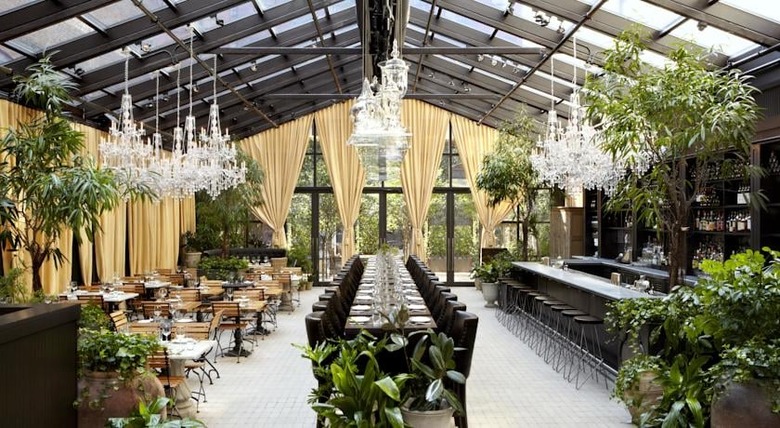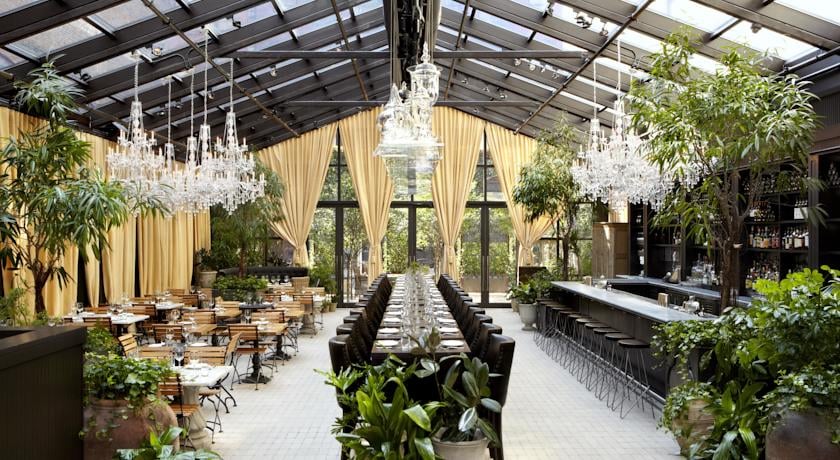The Revival Of The Espresso Martini, And Why You Need To Embrace It
The espresso martini became popularized in the 1980s as a way of waking party-goers up before a night out. Since then, the cocktail has had more of a... mixed reception. While it's become the drink of choice for many late-night revelers in Australia and Europe, here in the US, its popularity isn't as rampant. There's a common recollection of a highly sugary, artificial-tasting beverage, overdosed with a plethora of liqueurs, coffee substitutes, syrupy, and sickly sweet.
But times have changed since that insipid sugar hit. And, now, with a new found appreciation for quality coffee and more inspired cocktails, bars across America have seen a resurgence in the popularity of espresso martinis. The Nomo Soho proudly boasts one of New York City's best espresso martinis. It's a perfectly pieced together artwork of a rich and deep brown drink with a fantastically frothy layer of white foam on top, and it delivers the refreshingly delicious pick me up you need to kick start your night out.
Xavier Herit, the beverage manager of the Nomo Soho who created their version of the classic drink, argues that there's a misconception that espresso martinis are still the heavily sugared, sickly sweet drink that bar-goers were served decades ago. Like many coffee connoisseurs, he believes that the best espresso martinis need to be created with quality, fresh coffee, and that flavor needs to take the stage front and center.
In other words, vanilla ice cream, Baileys, or chocolate sauce should never be seen in an espresso martini.
"The espresso martini was very, very sweet before," Herit explains. He reminds me when bars used to serve guests ridiculously sweet (and artificially flavored) apple martinis and other concoctions resembling fluorescent science experiments. "Everybody's a lot more educated on what they eat and drink now, and they care more about their health. Not everybody wants really sweet drinks." While the past versions of espresso martinis were overloaded by ingredients, its revival has focused on prioritizing a quality coffee base.
Herit believes in simplicity, but quality. His attempts to create the perfect espresso martini results in numerous different recipes – some with white sugar, some with brown, and finding the right balance of Grey Goose and Kahlua. "Less is more. Just get the right ingredients in it, and it tastes better," he tells me. "It's not the most creative drink, but I wanted to do it right and give the guests the best one. You need good vodka like Grey Goose, we add a double espresso shot – something really robust, a coffee liqueur to reinforce the flavor and give it body, and a little sweetener to balance the whole drink." At the end of it all, good coffee is, and rightfully so, the star, taking center stage.
The end result is a truly harmonious collaboration of alcohol and caffeine. It's a symphony of earthy rich and aromatic tones in a full bodied and luxurious beverage of caffeinated heaven. It's also meant to be perfectly photogenic, with its chromatic layering ready to be 'grammed immediately.
"It should be foamy, because after you shake the espresso there should be a nice foam on top," says Herit. "It should have a beautiful coffee flavor and color. If I see a flat espresso martini with no foam, I want to ask, 'did you use old drip coffee from two days ago?'" I firmly support his rules, and personally, would run from any bar creating an espresso martini without fresh actual espresso.
Throw away your old preconceptions of yesteryear's espresso martini. It's not a heavily sweetened drink, or a drink overflowing with sugary artificial liquors or syrups. It shouldn't have ice cream in it, and above all, it has to use real coffee. Again, I'm not talking just coffee-flavored liquors, but actual espresso. There's a loyal underground cult following for good espresso martinis. You just have to search for them. But when you do discover your local brewer of this caffeinated delight, you'll be hooked – resulting in you latching on to your barman in a special relationship that's traditionally only seen with hairdressers and therapists.

